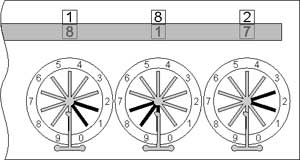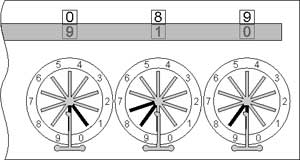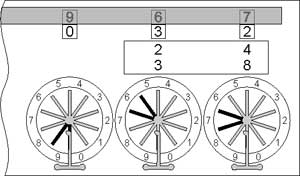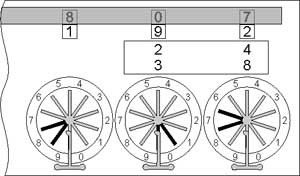
The input wheels (used for entering of numbers) are smooth wheels, across which periphery are made openings. Counter-wheels are crown-wheels, i.e. they have openings with attached pins across periphery.
The movement is transferred from the input wheel (marked with N in the sketch), which can be rotated by the operator by means of a stylus, over the counter, which consists of four crown-wheels (marked with B1, B2, B3 and B4), pinion-wheel (K), and mechanism for tens carry (C), to the digital drum (I), which digits can be seen in the windows of the lid.
working in this way:
On the counter-wheel of the junior digital positions (B1) are mounted two pins (C1), which during the rotating of the wheel around its axis (A1) will engaged the teeth of the fork (M), placed on the edge of the 2-legs rod (D1). This rod can be rotated around the axis (A2) of the senior digital position, and fork has a tongue (E) with a spring. When during the rotating of the axis (A1) the wheel (B1) reach the position, according to the digit 6, then pins (C1) will engaged with the teeth of the fork, and in the moment, when the wheel moves from 9 to 0, then the fork will slide off from the engagement and will drop down, pushing the tongue. It will push the counter wheel (B2) of the senior position one step forward (i.e. will rotate it together with the axis (A2) to the appropriate angle. The rod (L), which has a special tooth, will serve as a stop, and will prevent the rotating of the wheel (B1) during the raising of the fork.
The wheels of the calculating mechanism are rotating only in one direction. This means, that the machine can work only as a adding device, and subtraction must be done by means of a arithmetical operation, known as complement to 9. This inconvenience can be avoided by adding of additional intermediate gear-wheels in the mechanism.
On the surface of cylinders are inscribed 2 rows of digits in this way, that the pairs are complemented to 9, for example if the upper digit is 1, the lower is 8. On the lid is mounted a plate (marked with 2 in the lower sketch), which can be moved upwards and downwards and by means of this plate, the upper row of digits must be shown during the subtraction, while the lower one—during the addition. If we rotate the wheels, we will notice that digits of the lower row are changing in ascending order (from 0 to 9), while the digits of the upper row are changing in descending order (from 9 to 0).
Zeroing of the mechanism can be done by rotating of the wheels by means of the stylus in such way, that between the two starting spokes (marked on the wheel) to be seen 9 (see the lower sketch). In this moment the digits of the lower row will be 0, while the upper digits will be 9 (or 12 or 20, for sols and deniers) (see the lower sketch).

we will describe a way, which is optimal as number of operations, needed for performing of calculations. To use this way however, the operator must know the multiplication table (during the multiplication operation), and to be able to determine a complement to 9 for digits (for addition and subtraction). This is an easy task even for 8 years old child now, but not for the men of XVII century. Of course, the calculations can be done without 2 upper requirements, but will be necessary more attention and movement of the wheels.
First, let's make an addition, for example 64 + 83. We have to put the stylus between the spokes of the units wheels, against 4 and to rotate the wheel to the stop. In the lower row of windows (the upper was hide by the plate) we will see 4. Then we rotate the wheels of the tens by the same way to 6. Then we have to enter the second addend, 83, and we will see the result, 147, meanwhile one carry will be performed.
The subtraction will be a little more difficult and will require not only rotating, but some mental work. Let's make, for example, 182–93.
After zeroing of the mechanism (to see 000 in the lower windows), the plate of the windows must be moved in lower position and at this moment in the windows can be seen the number 999. Then the minuend is entered as a complement to 9, i.e. the units-wheel is rotated for 7, the tens-wheel for 1, and hundreds-wheel to 8 (the complement to 9 of 182 is 817). As the upper row of digits actually is moved to descending order, thus we have made a subtraction 999-817 and the result is 182 (see the lower sketch).

Subtraction (first phase)
Then must be entered the subtrahend (93), making a subtraction 182–93 (during rotating of the wheels two carries will happen—during the entering of the units (3), the units wheel will come to 9, and a carry to the tens-wheel wheel will be done, moving the tens-wheel to 7; then during the entering of 9 to the tens-wheel, it will be rotated to 8, and a carry will be transferred to the hundreds-wheel, making it to show 0). So, we have the right result 182–93=089 (see the lower sketch).

Subtraction (second phase)
It wasn't difficult, but the operator must be able to determine complement to 9 of a number.
To be able to use the fastest way for multiplication, the operator must know (or use) a multiplication table. Let's make the multiplication 24 x 38. First we have to multiply (mentally or looking at the table) units of the multiplicand to the units of the multiplier (8 x 4 = 32) and enter the result 32 in the mechanism (see the lower sketch).

Multiplication (first phase)
Then we have to multiply units of the multiplier to the tens of the multiplicand (8 x 2 =16), but to enter the result (16) not in the rightmost digital positions (for units and tens), but in the next (the positions for tens and hundreds). This we will have the result 192 (32 + 160) (see the lower sketch).

Multiplication(second phase)
Then we have to repeat the same operation for multiplication of the units of the multiplicand to the tens of the multiplier (3 x 4 =12) and for multiplication of the tens of the multiplier to the tens of the multiplicand (3 x 2 = 6), entering the intermediate results into wheels of tens and hundreds (12), and into the hundreds and thousands (06). We have the right result (912) (see the lower sketch).

Multiplication (third phase)
The division with the can be done in the way, similar to the manual division of the numbers—first we have to separate the dividend to 2 parts (according to the value of the divisor). Then we have to perform consecutive subtractions of divisor from the selected part of dividend, until the remainder will become smaller then the part. In this moment we have to write down the number of subtractions, this will be the first digit of the result. Then we have to attach to the remainder (if any) 1 or more digits from the remained part of the dividend and to start again the consecutive subtractions, until we receive the second digit of the result and to continue this operation again and again, until the last digit of the dividend will be used. At the end we will have the remainder of the division in the windows, while the result will be written.






